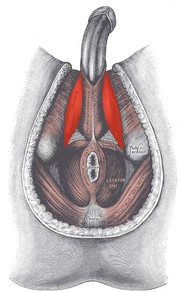Ischiocavernosus muscle
| Ischiocavernosus muscle |
|---|

Ischiocavernosus muscle in men
Ischiocavernosus muscle in women
|
| origin |
| Ramus ossis ischii (together with the crus penis or the crus clitoridis) |
| approach |
| (Tunica albuginea des) Corpus cavernosum (penis or clitoridis)
Fascia penis profunda or Fascia clitoridis profunda |
| function |
| Strengthening the erection through:
reflex or voluntary compression of the dorsal sections of the corpora cavernosa penis or corpora cavernosa clitoridis and thereby a massive increase in blood pressure in the organ and inhibition of venous blood outflow of the deep dorsal vein or the deep clitoral vein |
| Innervation |
| Pudendal nerve |
| Spinal segments |
| S2-S4 |
The ischiocavernosus muscle (from Latin musculus "muscle"; from Greek ìschion "buttocks", "socket of the hip joint", "buttock", "seat hump", "seat bone"; from Latin caverna "cavity", "cave"; "from the ischium" "Muscle running to the erectile tissue") is located below the perineum and belongs to the striated muscles . In mammals, the muscle is developed in both sexes. The ischiocavernosus muscle is innervated by the pudendal nerve , which comes from segments two to four of the cross section of the spinal cord.
function
The ischiocavernosus muscle is used to strengthen the erection in the final rigid-erection phase by exerting compressions on the base of the erectile tissue , which build up a greatly increased blood pressure in the corpus cavernosum penis . This can be a multiple of the systolic blood pressure (upper blood pressure value), 400 mmHg in humans and 1000 mmHg in other mammals . In addition, through its compression work, the muscle inhibits the venous blood outflow of the corpus cavernosum penis or the corpus cavernosum clitoridis through the vena profunda penis or the vena profunda clitoridis. Identical functions of the muscle have also been demonstrated for the nocturnal erection during sleep.
control
The muscle is controlled both reflexively via the vegetative nervous system and voluntarily via the somatic nervous system.
Reflective
During the erection phase, sensory signals from the glans penis trigger the compression work at the base of the penis to increase the erection. During ejaculation , the muscle synchronizes with the other rhythmic contractions in the organ to expel the semen. Both reflexes are called the bulbocavernosus reflex .
Arbitrarily
Arbitrary use of the muscle is used for pelvic floor training , for a variety of medical reasons, or to support the deliberate delay or avoidance of ejaculation.
Web links
- H. Jastrow: The human muscles in tables. University of Mainz
Individual evidence
- ^ MH Schmidt, HS Schmidt: The ischiocavernosus and bulbospongiosus muscles in mammalian penile rigidity. In: Sleep. Volume 16, Number 2, February 1993, ISSN 0161-8105 , pp. 171-183, PMID 8446838 (Review).
- ^ RC Dean, TF Lue: Physiology of penile erection and pathophysiology of erectile dysfunction. In: The Urologic clinics of North America. Volume 32, number 4, November 2005, ISSN 0094-0143 , pp. 379-95, v, doi: 10.1016 / j.ucl.2005.08.007 , PMID 16291031 , PMC 1351051 (free full text) (review).
- ^ Hermann van Ahlen, Sabine Kliesch: Disorders of Erection, Cohabitation, and Ejaculation. In: Eberhard Nieschlag, Hermann M. Behre, Susan Nieschlag: Andrology. Male Reproductive Health and Dysfunction Springer Science & Business Media, 2010, 629 S., S. 279-322, ISBN 3-540-78355-5 , S. 285f.
- ^ Gregory B. Auffenberg, Brian T. Hellfand, Kevin T. McVary: Normal Erectile Physiology. In: Kevin T. McVary: Contemporary Treatment of Erectile Dysfunction. A Clinical Guide Springer Science & Business Media, 2010, 299 S., S. 11-22, ISBN 1-60327-536-3 , S. 15.
- ↑ P. Lavoisier, R. Aloui, J. IWAZ, MJ Kokkidis: The physiology of penile rigidity. In: Progrès en Urologie. Volume 2, Number 1, February 1992, ISSN 1166-7087 , pp. 119-127, PMID 1299511 (review).
- ^ P. Lavoisier, J. Proulx, F. Courtois, F. De Carufel, LG Durand: Relationship between perineal muscle contractions, penile tumescence, and penile rigidity during nocturnal erections. In: The Journal of Urology. Volume 139, Number 1, January 1988, ISSN 0022-5347 , pp. 176-179, PMID 3336091 .
- ↑ P. Lavoisier, R. Aloui, M. Schmidt, M. Gally: Supra-systolic elevation of the intra-cavernous pressure secondary to stimulation of the glans penis. In: Annales d'urologie. Volume 27, Number 3, 1993, ISSN 0003-4401 , pp. 166-171, PMID 8352579 .
- ^ Gregory B. Auffenberg, Brian T. Hellfand, Kevin T. McVary: Normal Erectile Physiology. In: Kevin T. McVary: Contemporary Treatment of Erectile Dysfunction. A Clinical Guide Springer Science & Business Media, 2010, 299 S., S. 11-22, ISBN 1-60327-536-3 , S. 15.
